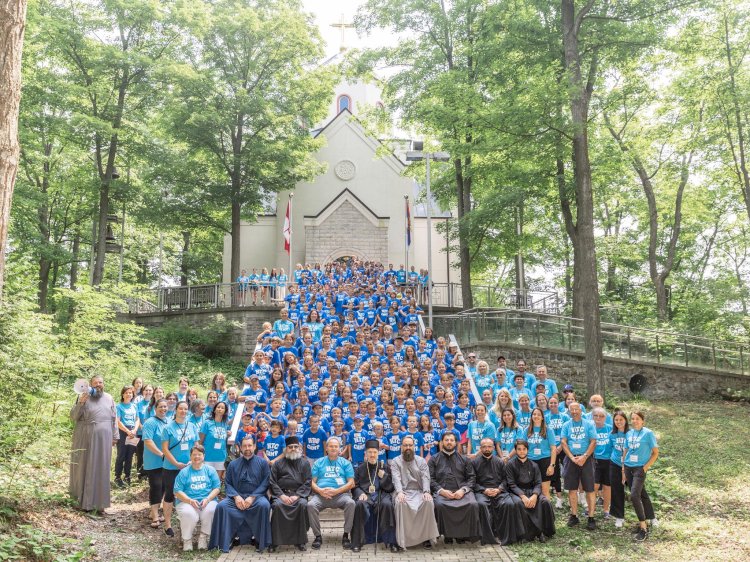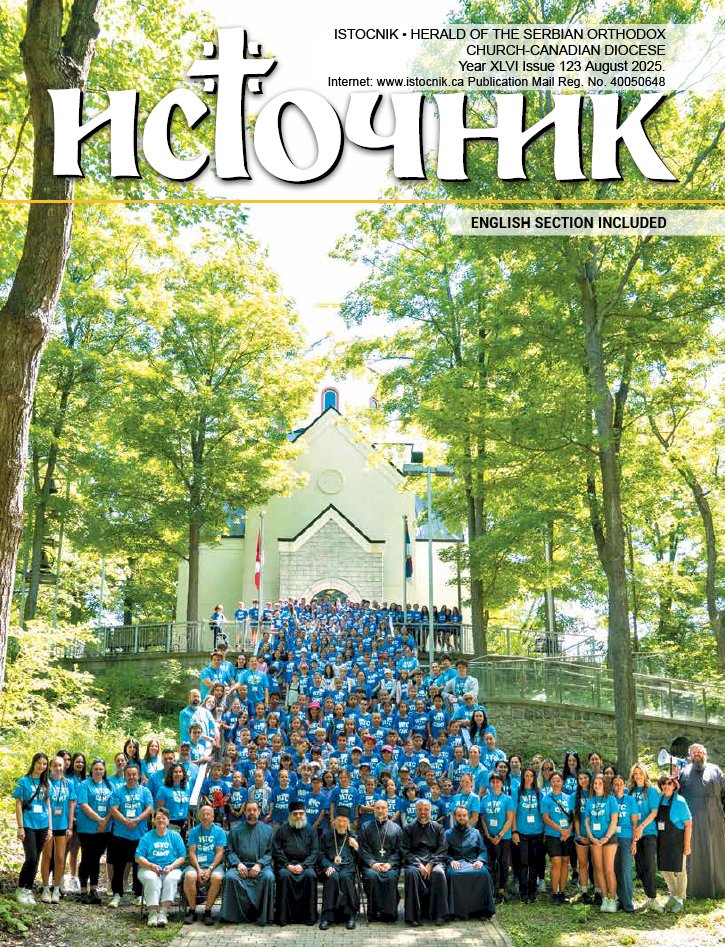
The Serbian Orthodox Diocese of Canada was founded by the Holy Assembly of Bishops of the Serbian Orthodox Church on May 26, 1983; all done at the initiative of then-Bishop of Eastern America and Canada Christopher (Kovacevich). Bishop Christopher was also the first administrator of the diocese until the election of a new Bishop of Canada.
At its regular meeting on May 16, 1984, the Holy Assembly of Bishops elected syncellus Georgije (Djokic), the confessor of Tavna monastery, as the first Bishop of Canada. His Holiness the Serbian Patriarch German consecrated him to the rank of Bishop on July 8th of the same year in the Cathedral of St. Michael the Archangel in Belgrade. On the feast of the Protection of the Most Holy Mother of God, October 14, 1984, Bishop Georgije was enthroned in the Cathedral of St. Nicholas in Hamilton (153 Nash Rd. S).
This was all the result of the trending growth in the Serbian population, and the resulting development of church life among Serbs in this vast country. The first Serbian Orthodox Church-School Congregation on Canadian soil was founded in 1912 in Regina (Saskatchewan) by immigrants mostly from Banat. The church in Regina was completed and consecrated in honour of the Most Holy Trinity in 1916. Serbs in Hamilton (Ontario) founded their congregation in 1913, and the temple dedicated to St. Nicholas the Wonderworker (on Beach Road) was consecrated on December 15, 1917. This temple was demolished when the local steel mill expanded its facilities and a beautiful new church was erected on Barton Street.
Church life for Serbs between the two world wars was marred by great difficulty in finding a method for clergy to serve in our churches and reach all of our newcomers. These problems are described in a letter which the first Bishop of America and Canada Mardarije addressed to the Holy Synod of Bishops in 1934 stating:
“We sent missionaries and monks, but not one of them was able to last more than two or three months. Married priests even less. The Hamilton parish covers a territory much bigger than all of Yugoslavia. There are several small colonies of two or three Serbian families which are hundreds and thousands of kilometres apart. Our neighbouring parish, which is located as far away as Belgrade is to Stockholm, is in Regina, and is even more difficult to manage.”
The influx of Serbian immigrants after the Second World War gave birth to new communities in Windsor, Toronto and Niagara Falls (Ontario); Vancouver (British Columbia); Lethbridge (Alberta) and Montreal (Quebec). The year 1963 saw dramatic changes in the life of the Serbian Orthodox Church on the North American continent. For the first time in its history the Serbian Church is victim to a schism which lasts 29 years. The result of the schism is that a portion of the parishes separate themselves from the Mother Church, and under the leadership of Bishop Dionisije form the Free Serbian Orthodox Church (later known as the New Gracanica Metropolitanate). Administrative changes are implemented among the parishes which remain loyal to Belgrade as well. The former Diocese of America and Canada is divied into three new dioceses: the Central-Western American, Western American, and Eastern-American and Canadian dioceses. The first Bishop of the Diocese of Eastern-America and Canada was Stefan (Lastavica) who presided from 1963 to 1967. He was followed by Bishop Sava (Vukovic), and from 1978 Bishop Christopher (Kovacevich).
Since its founding, specifically since the enthronement of the first Bishop of Canada in 1984, the Serbian Orthodox Diocese of Canada has seen the consecrations of many churches as well as church halls, rectories, and one retirement home (in Windsor, Ontario). The crown of all building endeavours of Bishop Georgije and the Serbian Orthodox Diocese of Canada is the Holy Transfiguration Monastery in Milton. The cornerstone of the first Serbian Orthodox monastery in Canada was blessed by His Holiness Serbian Patriarch Pavle on October 21, 1992. The monastery church was consecrated on June 12, 1994 while the episcopal palace (the new diocesan headquarters/living quarters) was completed in February 1995. It is also noteworthy to mention the former Saint Tsar Lazarus Benevolent Fund which was granted the Order of St. Sava in 1996 by the Holy Synod of the Serbian Orthodox Church for its contribution to humanitarian relief directed mostly toward the war-torn regions of Republika Srpska and Serbian Krajina.
The Serbian Orthodox Diocese of Canada encompasses the whole country with 33 parishes and missionary parishes. This includes the six parishes which until the full integration of the Constitution of the Serbian Orthodox Church in North and South America in 2009 were numbered in the New Gracanica Metropolitanate. This is living proof that the act of canonical reunification was a God-pleasing event and that all churches (except St. Michael the Archangel Church, in Toronto, on Delaware Avenue) with one heart and one soul celebrate the name of God in Canada.
By the decision of the Holy Assembly of Bishops of the Serbian Orthodox Church on May 20, 2015, Bishop Georgije was permanently removed from his role as ruling hierarch and His Holiness Irinej, the Serbian Patriarch, was named as the administrator of the Diocese of Canada with all rights and duties of a ruling bishop. He remained in this temporary position until the election of the then-Bishop of Eastern America, Mitrofan, on May 25, 2016. Bishop Mitrofan was enthroned on September 18, 2016, in the All Serbian Saints Church in Mississauga.
Publishing

The Serbian Orthodox Diocese of Canada, at the initiative of Bishop Georgije, launched its own magazine called Istocnik in December 1987, named in honour of the Dabro-Bosanski Istocnik which was published in Sarajevo in the 19th century. Shortly thereafter, the publishing house of the same name began operating, and has published more than a dozen books to date. In addition to books, Istocnik also publishes bilingual pocket calendars every year. The magazine is dedicated primarily to Christian and theological topics, as well as literature, culture and life of Serbs in Canada. The magazine is published three times (for Pascha, the Transfiguration of our Lord, and for Christmas) a year in a circulation of 5000 copies. The magazine’s Patron Saint Day is Easter Friday. The logo was designed by Dusan "Bata" Bijelic. Istocnik is also the name of the diocese’s website, which has existed since 1998. For its contribution to the development of Serbian culture, the magazine was awarded the Vuk Award for 2005, while the publishing house was awarded the Rastko Petrovic Award for 2006. In addition to print, the magazine has also been available in digital format since January 2012.
Diocesan Circle of Serbian Sisters

Known throughout America and Canada, the Circle of Serbian Sisters are a living and integral part of their holy Orthodox Church and, serving their faith, family, and kin, they bear witness to the tradition of the evangelical Myrrhbearers.
In Canada, founded in the early 1920s and 1930s, most of them have grown into exemplary organizations, known for their endowment work and for their cultural and national activities. By helping and beautifying the temples of the Lord and enriching the church life of each parish, the Circle of Serbian Sisters has become firmly established in the life of the Church and the Serbian Orthodox Diocese of Canada. With their self-sacrificing work, serving their holy Church, the Circle of Serbian Sisters has made an irreplaceable contribution to the creation, strengthening and development of the Diocese of Canada. Many of the circles have published memorials of their work and life on the occasion of the anniversaries of their foundation.
With the establishment of the independent Serbian Orthodox Diocese of Canada, the sister duties and obligations were elevated to the level of a diocese. Thus, the need arose to establish a Diocesan Circle, which was primarily supposed to take care of the residence of the bishop, the ceremonies of the diocese and, according to its capabilities, contribute to the maintenance of the newly established Diocese of Canada. Its special duties are to connect and unite the work of the church circles, to cooperate closely with the local church circles and to coordinate the activities of everyone on the religious and cultural-educational plans of the Diocese of Canada.
At the founding assembly of the Diocesan Circle of Serbian Sisters at the Serbian Centre in Mississauga on February 2, 1985, the board of directors – headed by the first president Milka Milunovic – voted on the DCSS bylaws in accordance with the Constitution of the Serbian Orthodox Church and the Constitution of the Serbian Orthodox Church in the United States and Canada. That same year, fifteen local church circles united in the DCSS, which became an organization with over 610 members. The number of members has fluctuated over the years but has always remained at an enviable level. The Diocesan Circle is still very active and has received numerous new members, especially after a new wave of Serbian immigrants came to Canada after the outbreak of war in Yugoslavia. This younger generation of sisters, whose membership in individual circles is increasing, worthily continues the tradition of their grandmothers and their mothers, and they are committed to the further progress of our diocese.
We prayerfully remember all deceased sister members every year on the feast of the DCSS on All Saints Sunday – the patron of the DCSS. We pray for the repose of their souls and cherish the memories of all of them among us. We remember our older sisters, our honorary members – who, with their families, served their Church with long years of work.
Holy Transfiguration Camp

Since 2018, with the hierarchical blessing of Metropolitan of Canada Dr. Mitrofan and on the initiative of the Vice President of the Saint Sava Youth Fund Rajko Djurdjevic, a summer children's camp has been held on the property of the Holy Transfiguration Monastery in Milton. The camp brings together hundreds of children aged six to fifteen from parishes throughout the Diocese of Canada, providing them with the opportunity to grow in faith, unity and love for the Orthodox Church. The daily program (five days from Monday to Friday) includes the Holy Liturgy, religious education, confession and communion, as well as a variety of artistic, creative and sports activities. Special attention is paid to church singing and spiritual songs, through which children learn to pray, praise God and feel the beauty of Orthodox music and spirituality. The camp represents a blessed expanse of children's joy, prayerful spirit, and brotherly love, founded on the efforts of clergy, teachers, and dedicated volunteers – all for the glory of God and the growth of children in Christ.






